One of the best things you can do for a sore back is to stretch. Stretching a sore back can help bring back some suppleness and increase in mobility, decrease back pain and discomfort, and improve your range of motion.
An important note about stretching
Never continue a stretch or take part in any activity that hurts your back. Take it easy, and remember to always seek the advice of a professional.
Learn more about our team of chiropractors and how they can help.
Stretching should be pain free, so never force your body into difficult positions. Move into the stretch slowly and avoid bouncing, which may actually tear muscles. Hold stretches long enough (15-30 seconds) to allow muscles or joints to become loosened.
Here are three stretches you can do at home to help your sore back.
Back Flexion Stretch:
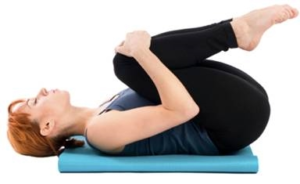 Start by lying on your back and pulling both knees to your chest, while simultaneously flexing your head forward into a balled-up position until you feel a comfortable stretch in your back. Repeat for 5 to 10 repetitions.
Start by lying on your back and pulling both knees to your chest, while simultaneously flexing your head forward into a balled-up position until you feel a comfortable stretch in your back. Repeat for 5 to 10 repetitions.
Continue lying down on your back with your knees all the way up as far as you can toward your chest. Hug them with your arms, then roll back and forth along your back. As your body rolls with your legs and arms tucked in, your back will get a nice stretch. This stretch is to be done slowly. Repeat for 5 to 10 repetitions.
Knee to Chest Stretch:
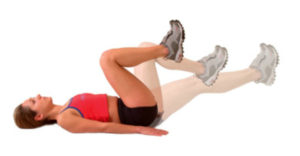 Start by lying on your back with the knees bent and both heels on the floor. Bring one knee to your chest and wrap both hands around your knee to increase the stretch. Hold for 15 to 30 seconds and repeat the stretch on the opposite leg. Repeat for 5 to 10 repetitions.
Start by lying on your back with the knees bent and both heels on the floor. Bring one knee to your chest and wrap both hands around your knee to increase the stretch. Hold for 15 to 30 seconds and repeat the stretch on the opposite leg. Repeat for 5 to 10 repetitions.
Hip Stretch:
While standing with feet shoulder-width apart, take a half-step back with the right foot, bend the left knee and shift weight back to the right hip. While keeping the right leg straight, bend forward more and reach down the right leg until a stretch in the outer hip is felt.
If you have persistent back pain (learn more about chronic back pain) please seek out medical help from your health care practitioner. They can rule out any serious aliments or conditions, and then you can start one of the best things you can do for a sore back – STRETCH!



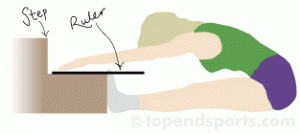 Remove your shoes and sit on the floor, legs extended in front of the body, toes pointing up and feet slightly apart, with the soles of the feet against the base of the step (if there is no step, any flat surface will work). Place the ruler on the ground between your legs or on the top of the step. Place one hand on top of the other, then reach slowly forward. At the point of your greatest reach, hold for a few seconds, and measure how far you have reached.
Remove your shoes and sit on the floor, legs extended in front of the body, toes pointing up and feet slightly apart, with the soles of the feet against the base of the step (if there is no step, any flat surface will work). Place the ruler on the ground between your legs or on the top of the step. Place one hand on top of the other, then reach slowly forward. At the point of your greatest reach, hold for a few seconds, and measure how far you have reached.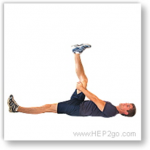 Lay flat on your back; bring up one leg at a time & hold onto the back of your thigh with one hand & the back of your calf with the other while using your hands to pull the leg towards you, keeping the knee bent. You will feel a strong stretch at the back of the middle of your thigh. If you can’t reach your leg use a towel around your legs to pull your leg towards you.
Lay flat on your back; bring up one leg at a time & hold onto the back of your thigh with one hand & the back of your calf with the other while using your hands to pull the leg towards you, keeping the knee bent. You will feel a strong stretch at the back of the middle of your thigh. If you can’t reach your leg use a towel around your legs to pull your leg towards you.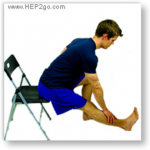 Sit on the edge of a chair with one leg bent and the other out in front of you. Lean forward keeping your back straight and your head up until you feel a stretch in the back of your thigh.
Sit on the edge of a chair with one leg bent and the other out in front of you. Lean forward keeping your back straight and your head up until you feel a stretch in the back of your thigh. Leg pain can range from a mild irritation to an unbearable pain that makes it difficult to complete any day-to-day activities. Leg pain can take many different forms, from a dull ache to searing pain. Other symptoms that may also occur are a pins-and-needle sensation, numbness or weakness.
Leg pain can range from a mild irritation to an unbearable pain that makes it difficult to complete any day-to-day activities. Leg pain can take many different forms, from a dull ache to searing pain. Other symptoms that may also occur are a pins-and-needle sensation, numbness or weakness.
